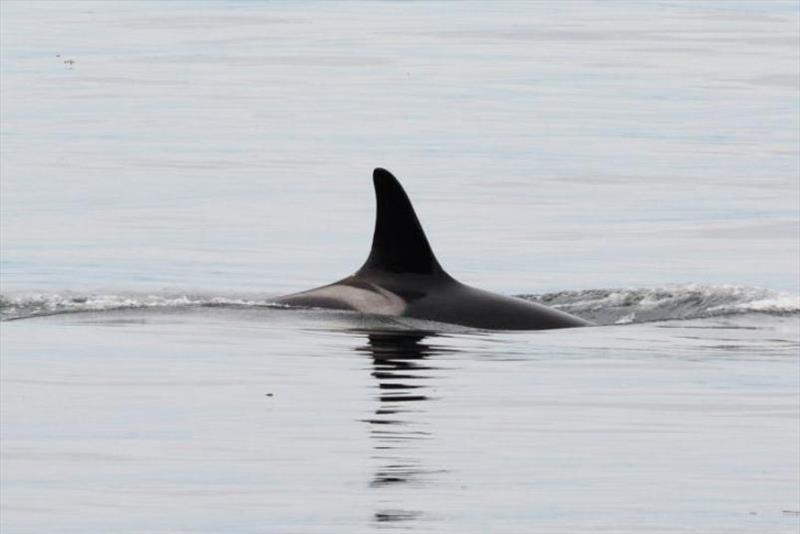
Lost whale L47 reflects the plight of endangered southern resident killer whales
by NOAA Fisheries 30 Oct 2021 16:24 UTC

Southern Resident killer whale L47, also known as Marina, was born in 1974, just after the last commercial captures of the now-endangered population © Jeanne Hyde / The Whale Museum
L47 was a mom, a grandmother, and a caregiver. Born in 1974, she contributed again and again to the endangered population of Southern Resident killer whales. She gave birth to seven calves over her 47 years.
Three survived, two of them females that also gave birth—L83 had calf L110 and L91 had L122. The loss of her other calves reflects the underlying problem facing the endangered orca population: Many calves do not make it to an age when they can start reproducing.
Now L47 is missing and has likely died. The Center for Whale Research observed her family group three separate times without L47. That is their guideline for determining that a whale is lost.
Her age was close to the average life expectancy for females—which is 50 years—but some have lived to 90 years or older. The most recent aerial photographs taken a year ago had not found her to be in poor condition. However, L pod overall trailed the other two Southern Resident pods in terms of body condition. The pod appeared to be on a declining trajectory, according to a 2020 report to NOAA Fisheries. The report was developed by a photogrammetry team led by Holly Fearnbach of SeaLife Response, Rehabilitation, and Research and John Durban of Southall Environmental Associates.
L pod is the largest of the three Southern Resident pods.
L47 became valuable caregiver
Grandparents such as L47 help care for the offspring of their daughters, just as human grandparents babysit and otherwise help their grandchildren. In the world of killer whales, the support of grandparents improves the odds that the youngest calves will survive and thrive to make contributions of their own. The loss of L47 decreases their odds of survival, the Center for Whale Research reported.
"Her role as a grandmother and mother to two reproductive females will be missed in the population," said Candice Emmons, a research scientist at the Northwest Fisheries Science Center.
The rate of unsuccessful pregnancies in the Southern Resident population has been estimated at more than 60 percent. The cause is even more difficult to tease apart. The losses cut across the population, and impact K and L pods. These pods take advantage of their time in the open ocean to diversify their diets to include other marine species in addition to their preferred Chinook salmon. They take a similar toll on J pod, which demonstrated a greater connection with Salish Sea and Fraser River salmon in the body condition study.
L47 reflected that same toll.
"She had more calves than some of the other females," said Brad Hanson, a research wildlife biologist at the Northwest Fisheries Science Center. "But her relatively high calf loss is indicative of the underlying problem the population is facing."
Multiple risk factors
The intertwined risk factors include:
- Availability of prey
- Toxic pollutants that accumulate in the whales' blubber and are transferred to calves
- Boat traffic and noise that can affect their behavior and foraging success
Inbreeding within the small population could also be a factor, research has indicated.
It's unclear if the seven calves L47 produced is an unusually high number for a Southern Resident. Scientists do not know if they get a full count of all newborn calves in the field, Emmons said.
That has been especially true in recent years when the Southern Residents have spent more of their time outside the inland waters of the Salish Sea and beyond the view of researchers. The recent finding from aerial photography that three J pod females are pregnant stands out as good news for the population.
Lower success for L Pod
While L pod includes 11 reproductive-age females, their reproductive success is lower than other pods because so many of the calves do not survive, Hanson said. While Southern Resident females might typically produce a calf roughly every 5 years, two of the L pod females appear to have never given birth. Others have produced only one or two known calves. K pod has an even more sparse record, without a successful calf in the last 10 years.
L47's first two calves, born when she was 16 in 1990 and 21 in 1995, survived. Her next four calves, born in 2000 and about every 2 years afterwards, did not. One more calf, born in 2010, survived. Scientists had enough glimpses of the calves at least briefly to know that they were alive at one point. However, no one knows precisely how long they lived or why they died.
"It is unfortunate that she lost so many calves," said Dawn Noren, a research biologist at the Northwest Fisheries Science Center. "Full-term pregnancies are costly. For a female to endure that without a benefit to the population in the end underscores the strain the population is under."